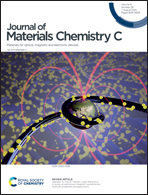Influence of the fullerene LUMO level on the stability of bulk heterojunction solar cells†
Abstract
Poly(3-hexylthiophene) (P3HT) is combined with a series of C60-based derivatives with LUMO energies varying between −3.53 and −3.83 eV, in order to study the influence of the fullerene LUMO level on the performance and stability of organic solar cells as well as the degradation of the photoactive materials. UV/vis measurements show that P3HT degrades more slowly in all investigated P3HT:fullerene blends compared to neat P3HT films when being irradiated in air. Accordingly, all fullerene derivatives stabilize P3HT against photo-oxidation, albeit to different extents, with the electron affinity of the fullerene determining the degree of stabilization. A fullerene LUMO level of −3.75 eV is found to cause maximum stabilization, while the degradation rate increases for higher and lower values. Remarkably, the higher the stabilization effect imposed by the fullerene the slower the fullerene degrades itself, which indicates a non-sacrificial mode of stabilization. Transient absorption spectroscopy measurements show similar kinetics of exciton quenching and charge generation for all P3HT:fullerene combinations indicating a similar morphology in all blend films. Inverted solar cells made from the different P3HT:fullerene blends exhibit a good correlation between fullerene LUMO level and open-circuit voltage. Upon illumination in air, the photovoltaic devices follow the same degradation trend as the isolated photoactive layers by showing the same dependence on the fullerene LUMO level. Finally, we discuss different mechanisms, by which fullerene acceptors are potentially able to stabilize (UV light screening, excited-state quenching, and radical scavenging) as well as destabilize (morphological effects, superoxide or singlet oxygen sensitization, and polymer triplet-state population) donor polymers.



 Please wait while we load your content...
Please wait while we load your content...